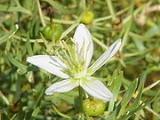
Nitrariaceae
Encyclopedia
Nitrariaceae is a family of flowering plant
s in the order Sapindales
. It comprises three genera, Nitraria
, Peganum
and Tetradiclis, totalling 16 species.
The family's main range is central Asia west to north Africa and southern Europe, but there are also species in Central America
and Australia
.
Flowering plant
The flowering plants , also known as Angiospermae or Magnoliophyta, are the most diverse group of land plants. Angiosperms are seed-producing plants like the gymnosperms and can be distinguished from the gymnosperms by a series of synapomorphies...
s in the order Sapindales
Sapindales
Sapindales is a botanical name for an order of flowering plants. Well-known members of Sapindales include citrus; maples, horse-chestnuts, lychees and rambutans; mangos and cashews; frankincense and myrrh; mahogany and neem....
. It comprises three genera, Nitraria
Nitraria
Nitraria is a genus of flowering plants in the family Nitrariaceae, native to Africa, Europe, Asia, Russia and Australia.There are about 9 species including:*Nitraria billardierei DC. , known as Nitre Bush or Dillon Bush...
, Peganum
Peganum
Peganum L. is a genus under the recently separated family Nitrariaceae . Formerly it used to be included in the family Zygophyllaceae....
and Tetradiclis, totalling 16 species.
The family's main range is central Asia west to north Africa and southern Europe, but there are also species in Central America
Central America
Central America is the central geographic region of the Americas. It is the southernmost, isthmian portion of the North American continent, which connects with South America on the southeast. When considered part of the unified continental model, it is considered a subcontinent...
and Australia
Australia
Australia , officially the Commonwealth of Australia, is a country in the Southern Hemisphere comprising the mainland of the Australian continent, the island of Tasmania, and numerous smaller islands in the Indian and Pacific Oceans. It is the world's sixth-largest country by total area...
.

